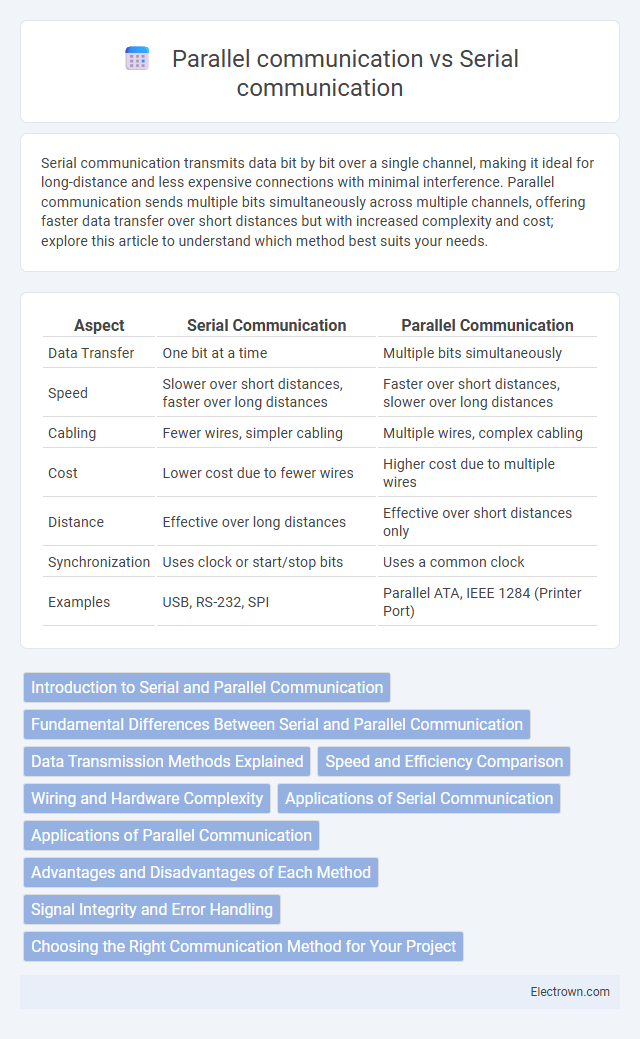Serial communication transmits data bit by bit over a single channel, making it ideal for long-distance and less expensive connections with minimal interference. Parallel communication sends multiple bits simultaneously across multiple channels, offering faster data transfer over short distances but with increased complexity and cost; explore this article to understand which method best suits your needs.
Table of Comparison
| Aspect | Serial Communication | Parallel Communication |
|---|---|---|
| Data Transfer | One bit at a time | Multiple bits simultaneously |
| Speed | Slower over short distances, faster over long distances | Faster over short distances, slower over long distances |
| Cabling | Fewer wires, simpler cabling | Multiple wires, complex cabling |
| Cost | Lower cost due to fewer wires | Higher cost due to multiple wires |
| Distance | Effective over long distances | Effective over short distances only |
| Synchronization | Uses clock or start/stop bits | Uses a common clock |
| Examples | USB, RS-232, SPI | Parallel ATA, IEEE 1284 (Printer Port) |
Introduction to Serial and Parallel Communication
Serial communication transmits data one bit at a time over a single channel, making it ideal for long-distance communication and reducing the number of physical wires needed. Parallel communication sends multiple bits simultaneously across multiple channels, offering faster data transfer rates for short distances but requiring more wiring and synchronization. Your choice between serial and parallel communication depends on factors like distance, speed, and hardware complexity.
Fundamental Differences Between Serial and Parallel Communication
Serial communication transmits data one bit at a time sequentially over a single channel, ensuring simplicity and reduced wiring complexity. Parallel communication sends multiple bits simultaneously across multiple channels, enabling faster data transfer but requiring more physical connections. The fundamental difference lies in data transmission method and hardware complexity, impacting speed, cost, and distance limitations.
Data Transmission Methods Explained
Serial communication transmits data one bit at a time over a single channel, making it ideal for long-distance communication and requiring fewer wires, which reduces cost and complexity. Parallel communication sends multiple bits simultaneously across multiple channels, offering faster data transfer speeds over short distances but facing issues like crosstalk and signal degradation at longer lengths. Understanding these data transmission methods helps you choose the optimal communication protocol based on distance, speed, and hardware constraints.
Speed and Efficiency Comparison
Serial communication transmits data bit by bit over a single channel, offering slower speeds compared to parallel communication, which sends multiple bits simultaneously across multiple channels. However, serial communication often achieves higher efficiency in long-distance transmission due to reduced signal degradation and crosstalk, whereas parallel communication can suffer from timing issues and signal skew. Modern high-speed serial protocols like USB 3.0 and PCIe have largely surpassed traditional parallel interfaces in both speed and efficiency.
Wiring and Hardware Complexity
Serial communication requires fewer wires, typically using one or two data lines, which reduces hardware complexity and cost compared to parallel communication. Parallel communication involves multiple data lines, often one per bit, leading to bulkier cables and increased pin count on connectors and integrated circuits. This wiring difference makes serial communication more suitable for long-distance and high-speed data transfer with simpler hardware design.
Applications of Serial Communication
Serial communication is widely utilized in applications such as USB devices, serial ports for microcontrollers, and network communications like Ethernet and RS-232 protocols. Its ability to transmit data bit by bit over a single channel makes it ideal for long-distance communication and reducing wiring complexity. Your choice of serial communication ensures reliable data transfer in embedded systems, telecommunications, and computer peripherals.
Applications of Parallel Communication
Parallel communication is widely used in applications requiring high-speed data transfer over short distances, such as computer memory interfaces, printer connections, and internal CPU data buses. It enables simultaneous transmission of multiple bits, making it ideal for transferring large volumes of data quickly within hardware components. Despite limitations over long distances, parallel communication remains essential in embedded systems, data acquisition devices, and high-performance computing environments where speed and bandwidth are critical.
Advantages and Disadvantages of Each Method
Serial communication offers advantages such as reduced wiring complexity, lower cost, and better performance over long distances, but it tends to have slower data transfer rates compared to parallel communication. Parallel communication enables faster data transfer by transmitting multiple bits simultaneously, making it ideal for short-distance communication, but it suffers from signal degradation, increased crosstalk, and higher costs due to more wiring. Your choice depends on the specific requirements of speed, distance, and cost efficiency in your communication system.
Signal Integrity and Error Handling
Serial communication offers superior signal integrity over long distances due to reduced crosstalk and electromagnetic interference, utilizing fewer conductors with differential signaling techniques like RS-485 or USB. Parallel communication, while faster in short distances by transmitting multiple bits simultaneously, often suffers from signal skew and crosstalk between closely spaced wires, leading to increased bit errors in high-frequency scenarios. Error handling in serial communication typically involves robust protocols such as CRC (Cyclic Redundancy Check) and retransmission mechanisms, whereas parallel communication may rely on simpler parity bits, which are less effective in detecting complex errors.
Choosing the Right Communication Method for Your Project
Selecting between serial and parallel communication hinges on factors like distance, speed requirements, and hardware complexity; serial communication offers longer cable lengths and simpler wiring, ideal for remote or low-pin-count applications. Parallel communication excels in high-speed data transfer over short distances, suitable for systems demanding rapid, simultaneous data input such as in microprocessor buses. Evaluating project-specific needs--data rate, noise immunity, cost, and scalability--guides the optimal choice for efficient and reliable data transmission.
Serial communication vs Parallel communication Infographic

 electrown.com
electrown.com